The CANT Z.511 is one of these fascinating "what if" of history. Initially planned as a transatlantic aicraft to link Italy and South America for Ala Littoria, the national company, the model came from a September 1937 request. For this, the Adriatic Shipyards (CANT) built the Cant.Z.511 A (Atlantico) whic made its first flight in 1939. This elegant four-engine long-range seaplane designed by Filippo Zappata as the war started in June 1940 for Italy, became military transport and "special raider". It was fitted to carry 4,000 kg (8,800 lb) of bombs or 454 mm (17.9 in) air-launched torpedoes for surface attack but the late version was the most fascinating, as the prototypes were tailored to carry one or two "Maiale" manned torpedoes or midget submarines for special operations in the port of New York... The ended on trials with the Aeronautica Nazionale Repubblicana but damaged by the RAF on Lake Trasimeno, transferred to Vigna di Valle where they ended the same.
 Between September 29 and October 1, 1937, CRDA (Cantieri Riuniti dell'Adriatico's Technical Office) created a series of 1:50 scale preliminary drawings. It stated a four-engined metal seaplane. This became the Cant.Z.511 designed by engineer Filippo Zappata. This was the largest float-based seaplane ever built. There were indeed larger flying boats, but it was believed the drag caused by a pair of floats, allowing the fuselage to remain streamlined, had an advantage over the drag-prone boat-hull fuselage of the former. Plus it would be easy to convert in a land-based version, and interested the military that in case of war, still could convert it as a fast, long range bomber.
Between September 29 and October 1, 1937, CRDA (Cantieri Riuniti dell'Adriatico's Technical Office) created a series of 1:50 scale preliminary drawings. It stated a four-engined metal seaplane. This became the Cant.Z.511 designed by engineer Filippo Zappata. This was the largest float-based seaplane ever built. There were indeed larger flying boats, but it was believed the drag caused by a pair of floats, allowing the fuselage to remain streamlined, had an advantage over the drag-prone boat-hull fuselage of the former. Plus it would be easy to convert in a land-based version, and interested the military that in case of war, still could convert it as a fast, long range bomber.
Zapatta (photo), which was the chief designer of arguably the largest and most famous seaplane manufacturer (and shipyard) in all of Italy, born in Ancona on 6 July 1894 and both a naval engineer by formation (at Genoa) and aviation engineer entered Cantieri Riuniti dell'Adriatico, CANT in Monfalcone in the late 1920s and became famous already with the giant Airline Aero Espresso Titano seaplane, and three awardds-winning models for Bleriot as his reputation grew. This design philosophy was simple, as he put it, «The most aerodynamic airplane is also the most beautiful». In 1930 he contributed to create CRDA, generating the CANT Z.506 Airone, Z.1007 Alcione, Z.501 Gabbiano, the model we see here, and postwar the helicopter Agusta A.101. He died in 1994 with the French Legion of Honour (1932) and Italian Medal of Aeronautic Valor (1991). The Z.511 in terms of floatplanes, was its crowning achievement, the last model he designed before the war, and one of the best known.
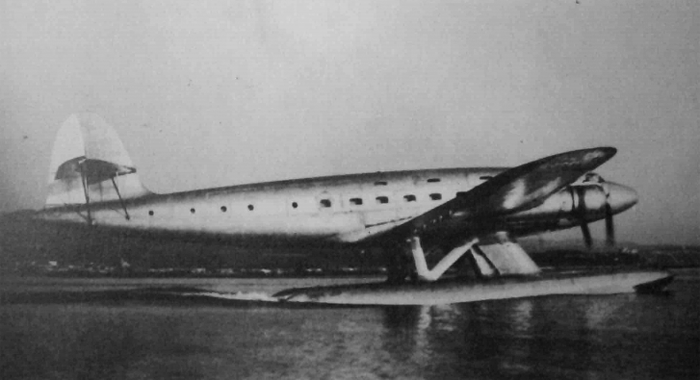
The first Protoype's water trials in 1942
This four-engine monster had a needle-shaped fuselage, wide at the middle and reduced forward and aft. The enclosed and profile cockpit had side-by-side seats, followed by the positions of the engineer and radio operator. Next, the fuselage was split into two levels, a lower one about 1 meter high being 15-meter-long baggage compartment, and the upper one with forty-eight seats, divided into four compartments of twelve seats each. This made it the largest Italian airliner so far. This passenger compartment had a toilet and a kitchenette close to the cockpit like modern airliners, with another toilet close to the tail plus a small storage closet. It was tailored for an Atlantic crossing and had unusual dimensions for the time. The cargo compartment was accessible in flight via two narrow crawl passages whioch also enabled to acess the wing halves and inspect the engines if needed or even the wingtip fuel tanks.
The engines closest to the fuselage could also be inspected via an internal ladder to the floats and from a side hatch for anchoring operations. Both floats were unique to the type, and 17.5 meters long, high enough to stand on them. They had internal bulkheads and storage space, notably for smaller anchors towing accessories. The only dark spot of the design, like many other Italian aircraft of the time, was the limited choices of powerful engines. The initial plan was for Alfa Romeo 135 engines were at the time in development. The latter lagged and only a few would be only available in 1943, delaying the whole program by four years. In total, these engines stayed in development for six years, starting with the 1937 announcement by Ala Litoria.
The final configuration was modified however on the last plans, in length, height, distance between floats, while the horizontal tailplanes ended larger. The nose section had a stepped construction similar to the Breda-Zappata BZ.308 land-based aircraft. On February 25, 1939, the Directorate General of Civil Aviation requested the Ministry to award the DGCA a contract for a second prototype as backup in case the first crashed in trials. The DGCA secured four million for it. Valle approved it on February 28, 1939 and by March 20 the construction contract was signed for 6,664,500 lire.
Then came the first tests with the Cant.Z.1015 and Cant.Z.1018, fitted with the Piaggio P.XII RC.35 engines, rated for 1,500 hp at take-off, 1,350 hp at 3,500 m. They were moderately successful, so it was decided to adopt the latter, albeit at this stage they were still plagued by reliability issues and delicate to maintain. Indeed, the Z.511 had an empty weight of 20,6 tons, total weight above 34 tons so there was no better option.
Initially, the P.XIIs were installed on the Cant.Z.511, enclosed in large-diameter cowlings. Fortunately they did not suffer from overheating problems so this allowed Zapate to made the cowlings more streamined with external bosses over the cylinder heads like for the Cant.Z.1018. All their air intakes were redesigned, and they also featured modifications to their exhausts. So bt October 1940 at last, tests were carried out in the hydrodynamic tank of the Guidonia Experimental Center. This was done with an 1/48 scale model, and they were positive.
Soon an opportunity to make the Z.511 came with the rescue of Italians trapped in Saudi Arabia, requesting to be picked up by a seaplane in the Red Sea. On January 9, 1942, the Chief of Staff of the Regia Aeronautica, General Rino Corso Fougier authorized the Cant.Z.511 to make such as flight with safety margins. However the prototype was still expected at Vigna di Valle to complete its military tests and needed further fine-tuning of its engines. General Giuseppe Casero asked Superaereo so asked instead to do this flight by a Cant.Z.509, which was negated based on range issues. On February 11, 1942, Superaereo instead to used a modified long-range SM.75, the I-LINI but the operation was eventually cancelled by February 20, 1942 for mainly political reasons. There were still 900 Italians in Saudi Arabia that could be turned as POWs at any moment.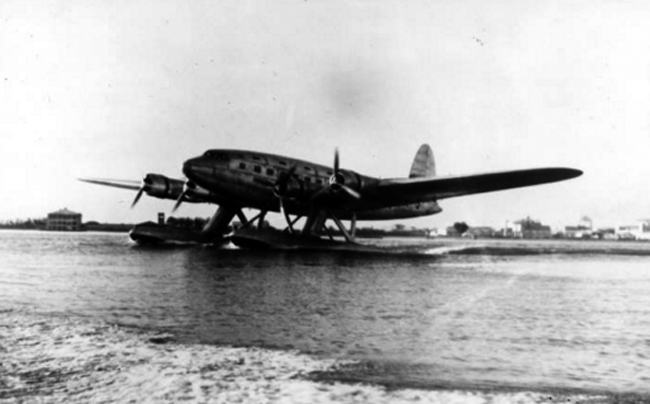
511 Atlantico with its initial silvery factory livery (M.386 Prototype) on trials at CRDA Montfalcone
At last came the first short flight of the Cant.Z.511 (Mario Stoppani and CRDA chief engineer Guido Divari and Zappata as well as the mechanic Renato Rovis). The Z.511 took off from Duino despite a strong wind. So string in fact, unsassisted command control were expectedly heavy and inertia caused by excessive elasticity in the cables preventer the aircraft paking a turn after take-off. Only by differentiating power left-right and prevented it crashing into the hills surrounding the Gulf of Monfalcone. He returned the massive aircraft and landed, prompting a complete overhaul of the control system. Tie rods were replaced by cables with rigid rods, over three months. More tests followed, sealing the Z.511 reputation as an excellent aircraft, with no vices and overall great performance.
Later flights determined loads and fuel consumption and by February 16, 1942, official flight tests were announced. Empty weight was determined a day later, climb rate of the 21st, and others on the 28th and March 3, takeoff tests on the 24-25 loaded at 28 and 34 tonnes. On March 24, sea trials were done when the weather deteriorated, in force 4, with 1.30 m swells, 55-65 km/h winds, plus a load of 34 tons. Takeoffs and landings with 25t in force 5 (1.50 m waves, 60 km/h winds) proved all positive, all the time under Stoppani in command.
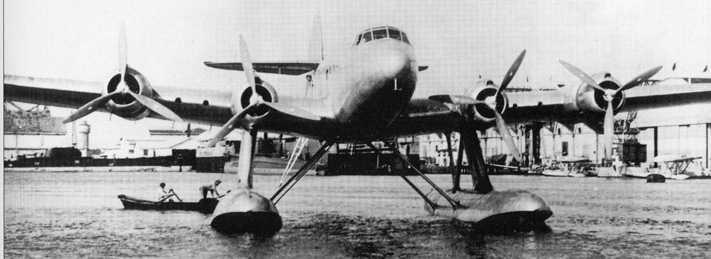
Front view of the still unpainted M.386 at Montfalcone.
The floats and structure withstood dynamic stresses of this battering. Towing tests off Punta Sdobba led to lengthen the floats for extra stability. On May 22, 1942, Stoppani made the transfer flight from Monfalcone to Vigna di Valle for a fuel consumption tests. This led to replace one outer engine that cracked. The passenger remained empty for all these tests, with a few experimental seats and most of the time, firmly strapped dead weight.
The elliptical-section fuselage recalled the one used by the 1949 Lockheed Constellation, proving that Zapatta was forward-thinking. It had a duralumin shell structure and skin as well. The Engines were as said above, Piaggio P.1002, fitted with three-bladed metal propellers, with variable pitch, and constant rating, and electrically controlled feathering. The fuel in wing tanks totalled 16,340 liters (11,930 kg) in addition to the fuselage auxiliary 1,335-liter tank. The cocskpit had a dual side-by-side controls and dashboard with all gauges for the engine control, instrumented flight as well as a Salmoiraghi autopilot. Behind the pilot were the engineer's stationand his own dashboard with all four engines's gauges and on the other side, the radio operator's station with two-way emitter-receptor and direction finder.
The passenger cabin of the prototype remained void, never fitted with seats nor soundproofed or thermally insulated. The first planned "VIP" configuration comprised 16 single seats reclining into bunks with individual lighting, ventilation and heating in four compartments for transatlantic configuration. In the high-density configuration there were 48 seats in four compartments of 12 each and ventilation and heating different in each. Toilet and kitchenette, second toilet, storage closet aft as seen above as well. The lower cargo compartment and its access to tunnels in the wing leading edge and floats was completed however.
In the now deserted storage bay of the fuselage could take place either four 450 mm (17.7 in) aerial torpedoes (two pairs + two pairs) instead of two standard 53.3 cm Si 270/533.4 x 7.2 "M" torpedoes, possibly mounted in a bulge below the fuselage. In a bomber configuration it was planned to stack up to 4,000 kg (8,800 lb) bombs in an internal bomb bay plus those under outer-wing hard-points. But the most ouststanding proposal in mid-1943 was its use to carry two "Maiale" manned torpedoes or one of two MT explosive motorboats. See 'career' for more details. None ever came to be.
Development
In its report of September 28, 1937 for its financial reports to its shareholders on June 30, Ala Littoria announced the study of a route to South America as a priority. From a technical standpoint, it was clear its current fleet was inadequate, and looked for a more modern three-engine aircraft with metal structure or better, a four-engine solution for a larger aircraft. It was believed a large fuselage would also better insulate it from vibrations from the central engine, which also impaired visibility from the cockpit. Debates concluded in favor of a seaplane pergaps over a land-based aircraft, as the large availability of watery surfaced compared to the scarcity of airfields at the time, was confirmed by choices amde by Short, Boeing, Latécoère, Dornier and Blohm-Voss to make this long range flights more secure. This new direction and intention of the company was cemented in 1938, driving forward the development of a new aircraft.Zapatta's M.M.386 prototype
 Between September 29 and October 1, 1937, CRDA (Cantieri Riuniti dell'Adriatico's Technical Office) created a series of 1:50 scale preliminary drawings. It stated a four-engined metal seaplane. This became the Cant.Z.511 designed by engineer Filippo Zappata. This was the largest float-based seaplane ever built. There were indeed larger flying boats, but it was believed the drag caused by a pair of floats, allowing the fuselage to remain streamlined, had an advantage over the drag-prone boat-hull fuselage of the former. Plus it would be easy to convert in a land-based version, and interested the military that in case of war, still could convert it as a fast, long range bomber.
Between September 29 and October 1, 1937, CRDA (Cantieri Riuniti dell'Adriatico's Technical Office) created a series of 1:50 scale preliminary drawings. It stated a four-engined metal seaplane. This became the Cant.Z.511 designed by engineer Filippo Zappata. This was the largest float-based seaplane ever built. There were indeed larger flying boats, but it was believed the drag caused by a pair of floats, allowing the fuselage to remain streamlined, had an advantage over the drag-prone boat-hull fuselage of the former. Plus it would be easy to convert in a land-based version, and interested the military that in case of war, still could convert it as a fast, long range bomber.
Zapatta (photo), which was the chief designer of arguably the largest and most famous seaplane manufacturer (and shipyard) in all of Italy, born in Ancona on 6 July 1894 and both a naval engineer by formation (at Genoa) and aviation engineer entered Cantieri Riuniti dell'Adriatico, CANT in Monfalcone in the late 1920s and became famous already with the giant Airline Aero Espresso Titano seaplane, and three awardds-winning models for Bleriot as his reputation grew. This design philosophy was simple, as he put it, «The most aerodynamic airplane is also the most beautiful». In 1930 he contributed to create CRDA, generating the CANT Z.506 Airone, Z.1007 Alcione, Z.501 Gabbiano, the model we see here, and postwar the helicopter Agusta A.101. He died in 1994 with the French Legion of Honour (1932) and Italian Medal of Aeronautic Valor (1991). The Z.511 in terms of floatplanes, was its crowning achievement, the last model he designed before the war, and one of the best known.

The first Protoype's water trials in 1942
This four-engine monster had a needle-shaped fuselage, wide at the middle and reduced forward and aft. The enclosed and profile cockpit had side-by-side seats, followed by the positions of the engineer and radio operator. Next, the fuselage was split into two levels, a lower one about 1 meter high being 15-meter-long baggage compartment, and the upper one with forty-eight seats, divided into four compartments of twelve seats each. This made it the largest Italian airliner so far. This passenger compartment had a toilet and a kitchenette close to the cockpit like modern airliners, with another toilet close to the tail plus a small storage closet. It was tailored for an Atlantic crossing and had unusual dimensions for the time. The cargo compartment was accessible in flight via two narrow crawl passages whioch also enabled to acess the wing halves and inspect the engines if needed or even the wingtip fuel tanks.
The engines closest to the fuselage could also be inspected via an internal ladder to the floats and from a side hatch for anchoring operations. Both floats were unique to the type, and 17.5 meters long, high enough to stand on them. They had internal bulkheads and storage space, notably for smaller anchors towing accessories. The only dark spot of the design, like many other Italian aircraft of the time, was the limited choices of powerful engines. The initial plan was for Alfa Romeo 135 engines were at the time in development. The latter lagged and only a few would be only available in 1943, delaying the whole program by four years. In total, these engines stayed in development for six years, starting with the 1937 announcement by Ala Litoria.
Context
Meanwhile between 1937 and 1939, Atlantic records and alternatives between seaplanes and land-based aircraft was an on-going debate for long-haul aviaton. Debates on the most suitable asset for transatlantic services were fed in Italy by the December 28-29, 1937 exploit by CRDA test pilot Mario Stoppani. He set a world distance record of 7,013 km with the Cant.Z.506 B I-LAMA between Cadiz and Caravelas in Brazil. On January 24-25, 1938, two Savoia Marchetti SM.79Ts commanded by Attilio Biseo and Bruno Mussolini started scheduled flights between Guidonia and Rio de Janeiro. The President of Ala Littoria, Umberto Klinger, and Commander Carlo Tonini, flew the Cant.Z.506 I-ALAL from Cagliari Elmas to Buenos Aires on March 20-26, 1938 as well. In Ala Littoria the Experimental Directorate for Atlantic lines was established (later LATI), headed by Attilio Biseo and in June 20, 1938, he urged a meeting to decide between a land-based or seaplane. Eventually it was decided for the first, as the best option from both a technical and commercial perspective.The prototype is finalized
In its report of September 30, 1938, Ala Littoria announced the construction of three Cant.Z.509s and the final development phase of the Cant.Z.511. The latter was under construction when examined by Benito Mussolini at CANT, Monfalcone on September 19, 1938. The contract was at last signed on October 13, 1938, with a scheduled date for a first flight on October 31, 1939, even though the company decided against a seaplane. Mussolini insisted to complete the development of the Z.511 A (Atlantico) as a matter of national prestige. So DGCA authorized and financed the remaining work with a cost evaluation of six aircraft.The final configuration was modified however on the last plans, in length, height, distance between floats, while the horizontal tailplanes ended larger. The nose section had a stepped construction similar to the Breda-Zappata BZ.308 land-based aircraft. On February 25, 1939, the Directorate General of Civil Aviation requested the Ministry to award the DGCA a contract for a second prototype as backup in case the first crashed in trials. The DGCA secured four million for it. Valle approved it on February 28, 1939 and by March 20 the construction contract was signed for 6,664,500 lire.
Engine Issues
The main problem aside remained the Alfa Romeo 135s, stuck in development hell. By December 1939 the first Cant.Z.511 was almost complete, the second in advanced stage of construction, but no engine was planned for them. So by December 27, 1939, it was decided to purchase six Wright Cyclone R-2600 A (2 B) engines in the US, models that had the reputation of being highly reliable for a power output of around 1,300 hp. Pricolo authorized the purchase on December 29, 1939, but the project stalled by the spring of 1940, and no engine was secured causing further delays before flight tests.Then came the first tests with the Cant.Z.1015 and Cant.Z.1018, fitted with the Piaggio P.XII RC.35 engines, rated for 1,500 hp at take-off, 1,350 hp at 3,500 m. They were moderately successful, so it was decided to adopt the latter, albeit at this stage they were still plagued by reliability issues and delicate to maintain. Indeed, the Z.511 had an empty weight of 20,6 tons, total weight above 34 tons so there was no better option.
Initially, the P.XIIs were installed on the Cant.Z.511, enclosed in large-diameter cowlings. Fortunately they did not suffer from overheating problems so this allowed Zapate to made the cowlings more streamined with external bosses over the cylinder heads like for the Cant.Z.1018. All their air intakes were redesigned, and they also featured modifications to their exhausts. So bt October 1940 at last, tests were carried out in the hydrodynamic tank of the Guidonia Experimental Center. This was done with an 1/48 scale model, and they were positive.
Enters the Military (1941)
As hostilities started for Italy with the invasion of Yugoslavia, by April 1941 the Cant.Z.511 was moved from Monfalcone to Grado to avoid it being targeted by a Greek raid. The Cantieri Riuniti dell'Adriatico shipyards were now under stricter security rules, with notably a dense AA battery cover. The first prototype Cant.Z.511 A MM.386 could no longer be used as an airliner so CANT suggesed a conversion to military use. Still in 1941, Capt. Giulio Marini proposed to modified the fuselage to carry two 533 mm torpedoes instead of the smaller, standard 450 mm models carried by trimotors. Their greater performances enabled a dropping beyond AA range. However the weight of an Italian 533m Torpedo such as the latest Si 270/533.4 x 7.2 "M" was 3,748 lbs. (1,700 kg) for a lenght of 23 ft. 7 in. (7.200 m). So a combined weight of 3.4 tonnes, still viable.Soon an opportunity to make the Z.511 came with the rescue of Italians trapped in Saudi Arabia, requesting to be picked up by a seaplane in the Red Sea. On January 9, 1942, the Chief of Staff of the Regia Aeronautica, General Rino Corso Fougier authorized the Cant.Z.511 to make such as flight with safety margins. However the prototype was still expected at Vigna di Valle to complete its military tests and needed further fine-tuning of its engines. General Giuseppe Casero asked Superaereo so asked instead to do this flight by a Cant.Z.509, which was negated based on range issues. On February 11, 1942, Superaereo instead to used a modified long-range SM.75, the I-LINI but the operation was eventually cancelled by February 20, 1942 for mainly political reasons. There were still 900 Italians in Saudi Arabia that could be turned as POWs at any moment.
First tests (1942)

511 Atlantico with its initial silvery factory livery (M.386 Prototype) on trials at CRDA Montfalcone
At last came the first short flight of the Cant.Z.511 (Mario Stoppani and CRDA chief engineer Guido Divari and Zappata as well as the mechanic Renato Rovis). The Z.511 took off from Duino despite a strong wind. So string in fact, unsassisted command control were expectedly heavy and inertia caused by excessive elasticity in the cables preventer the aircraft paking a turn after take-off. Only by differentiating power left-right and prevented it crashing into the hills surrounding the Gulf of Monfalcone. He returned the massive aircraft and landed, prompting a complete overhaul of the control system. Tie rods were replaced by cables with rigid rods, over three months. More tests followed, sealing the Z.511 reputation as an excellent aircraft, with no vices and overall great performance.
Later flights determined loads and fuel consumption and by February 16, 1942, official flight tests were announced. Empty weight was determined a day later, climb rate of the 21st, and others on the 28th and March 3, takeoff tests on the 24-25 loaded at 28 and 34 tonnes. On March 24, sea trials were done when the weather deteriorated, in force 4, with 1.30 m swells, 55-65 km/h winds, plus a load of 34 tons. Takeoffs and landings with 25t in force 5 (1.50 m waves, 60 km/h winds) proved all positive, all the time under Stoppani in command.

Front view of the still unpainted M.386 at Montfalcone.
The floats and structure withstood dynamic stresses of this battering. Towing tests off Punta Sdobba led to lengthen the floats for extra stability. On May 22, 1942, Stoppani made the transfer flight from Monfalcone to Vigna di Valle for a fuel consumption tests. This led to replace one outer engine that cracked. The passenger remained empty for all these tests, with a few experimental seats and most of the time, firmly strapped dead weight.
Design
The Z.511 was a float-based seaplane, four-engine, cantilever, low-wing monoplane, with an all-metal structure. It had a single-spar, trapezoidal wing in five sections (centerplane with engine mounts, wing halves, wingtips) all in duralumin structure and stressed skin. The ailerons and flaps with all metal and the same. There were walkable corridors within the wing leading edge. The Tailplane was also in duralumin, structure and skin but there were fabric-covered control surfaces. The elevator rudder was braced with steel tube struts. There was a rudder fin and elevator trim also covered in fabric. The Floats were also in duralumin, structure and skin, and were connected to the fuselage by a faired steel tube structure. Inside the large front one was installed an internal ladder connecting the float and wing tunnel.The elliptical-section fuselage recalled the one used by the 1949 Lockheed Constellation, proving that Zapatta was forward-thinking. It had a duralumin shell structure and skin as well. The Engines were as said above, Piaggio P.1002, fitted with three-bladed metal propellers, with variable pitch, and constant rating, and electrically controlled feathering. The fuel in wing tanks totalled 16,340 liters (11,930 kg) in addition to the fuselage auxiliary 1,335-liter tank. The cocskpit had a dual side-by-side controls and dashboard with all gauges for the engine control, instrumented flight as well as a Salmoiraghi autopilot. Behind the pilot were the engineer's stationand his own dashboard with all four engines's gauges and on the other side, the radio operator's station with two-way emitter-receptor and direction finder.
The passenger cabin of the prototype remained void, never fitted with seats nor soundproofed or thermally insulated. The first planned "VIP" configuration comprised 16 single seats reclining into bunks with individual lighting, ventilation and heating in four compartments for transatlantic configuration. In the high-density configuration there were 48 seats in four compartments of 12 each and ventilation and heating different in each. Toilet and kitchenette, second toilet, storage closet aft as seen above as well. The lower cargo compartment and its access to tunnels in the wing leading edge and floats was completed however.
Armament
The military came back to study a military conversion of the Z.511 after the attempted, then cancelled flight to Saudi Arabia in 1941 as it was too soon in development. Sources points out to configurations as seaplane bomber or torpedo attacker, with a defensive armament planned to be either ten 12.7 mm (0.5 in) Breda-SAFAT HMGs, or even ten 20 mm (0.787 in) Cannone-Mitragliera da 20/77 (Scotti) cannons in beam positions, with two upper turrets and belly positions. In any case, this would make a formidablly defended aircraft by axis or allies standards.In the now deserted storage bay of the fuselage could take place either four 450 mm (17.7 in) aerial torpedoes (two pairs + two pairs) instead of two standard 53.3 cm Si 270/533.4 x 7.2 "M" torpedoes, possibly mounted in a bulge below the fuselage. In a bomber configuration it was planned to stack up to 4,000 kg (8,800 lb) bombs in an internal bomb bay plus those under outer-wing hard-points. But the most ouststanding proposal in mid-1943 was its use to carry two "Maiale" manned torpedoes or one of two MT explosive motorboats. See 'career' for more details. None ever came to be.
⚙ specifications | |
| Empty Weight | 20,692 kg (45,618 lb) |
| Gross weight | 34,200 kg (75,398 lb) |
| Lenght | 28.5 m (93 ft 6 in) |
| Wingspan | 39.86 m (130 ft 9 in) |
| Height | 11 m (36 ft 1 in) |
| Wing Area | 195 m2 (2,100 sq ft) |
| Engine | 4× Piaggio P.XII RC.35 air-cooled radial piston engines, 1,100 kW (1,500 hp) |
| Top Speed, sea level | 424 km/h (263 mph; 229 kn) |
| Cruise Speed | 330 km/h (205 mph; 178 kn) |
| Range | 4,352 km (2,704 mi; 2,350 nmi) |
| Climb Rate | 4.16 m/s (819 ft/min) |
| Ceiling | 7,550 m (24,770 ft) |
| Armament | 10 MGs or autocannons, 4x 450 mm torpedoes, see notes |
| Crew | 6+ 16 passengers as transport |
Active service and Fate
Due to various manpower and material constraints by June 23, 1942, the second prototype was disassembled at CRDA. This summer, information was requested regarding also the condition and specs trialled by the MM.386. On August 14, 1942, was requested a complete picture on weight, flight performance, range, plus the test reports from the Vigna di Valle Experimental Center. It was reported that the Piaggio engines suffered from climb, top speed, and takeoff tests at full load and overload and urged their replacement before any operational mission.Such aicraft still generated enthusiasm and imagination from military planners, and there was a proposed scheduled Italy-Argentina flights. There were also on August 21, 1942 by Casero, a proposal of a "spec op" delivery aircraft, with small groups of Regia Marina sappers on important British (and later American) military or industrial installations. Mussolini however preferred a demonstration flight to South America. After the Rio de Janeiro Conference in January 1942, full solidarity with the United States of South America, and breaking with the axis, led only Argentina somewhat open to Italy.
A Wartime line to Argentina
So it was planned to used the Z.511 from Rome to Buenos Aires using with a single stopover at Murdeira Bay (Cape Verde), where LATI still personnel, installations and fuel plus a long range radio station as Buenos Aires was still 6,850 km away. Portugal could still oppose this stopover so a diversion was planned in the Spanish African colony of Rio de Oro, Cape Blanco, 7,500 km from Buenos Aires, or Villa Cisneros almost 8,000 km. Altitude planned planned at 3,000 meters and 4,000 meters over the Brazilian and Paraguayan territories. The final destination was the Rio de la Plata near Concepcion. For the return it was planned to use the Pampero, a strong northeastward wind and reach Bahia, then at 3,000 meters to the equator, and up again for transtlantic winds.It was also planned to replace the P.XIIs by the long-awaited Alfa Romeo 135s, which had better fuel consumption and were better suited to take off at 39 tonnes. But on October 20, 1942, General G.A.r.i. Fernando Bertozzi-Olmeda (General Directorate of Construction and Procurement) broke this expectation as he announced the Alfa Romeo 135s promising a range of 9,200 km would not be able to make a take-off possible beyond 36 tonnes. 12,5 tons of fuel made for 6,000 km at 330 km/h cruise speed and 60% engine power, so this make the whole prospect untenable.
The Raid of New York
By January 11, 1943, as the Z.511 was still without goal, Captain Armando Ulivi as well as Engineer Vuolo, and Armando Palanca arrived at Monfalcone to to test the Z.511 potential. In February it was flowed back to Vigna di Valle on Lake Bracciano for extra fuel consumption tests with the new engines. On February 7, 1943, General Eraldo Ilari (Construction and Supply) presided a meeting to see if a raid to New York for BETASOM, the submarine base in Bordeaux, France, stopping in mid-Atlantic to collect fuel from a submarine for the return flight, was a possibility. Initially instead of bombs or torpedoes, it was to carry a large shipment of leaflets over New York, which had at the time a large Italian-origin population, possibly sympathetic to the Duce. But this raid was replaced by one for the SM.95.Other planned Operations
It was alo planned to use it to raid allied Fuel Depots in the Persian Gulf or Black Sea, hitting hard Soviet supply there. On March 16, 1943, Casero requested assistance t study the project from Captain Publio Magini (Rome-Tokyo flight) with Ulivi, starting new fuel consumption tests at Vigna di Valle. But the war continued to go bad for Italy, and the plan never even reached preparatory stage.Fate of two Prototypes
"Production" figures of the model oftern points out only two models completed, the Cant.Z.511 A MM.386 prototype, second one, while the hypothetic third one was not even started. M386 was found where it was at Vigna di Valle seaplane base when the armistice was signed by the new Government on September 8, 1943. To prevent its captured by the Germans, its floats were pierced byh pickaxes until it sank settled on shallow water. Allied troops arrived around Rome area in June 1944, and led a push across Lake Bracciano. One of the large rubber dinghies was severed underway by a propeller blade from the submerged Z.551 and the sinking boat saw the immediate sinking of a Sherman tank, dropped on the aircraft below and badly damgaining it.By late 1945 it was decided to clear the lake littered with wreckage. An explosive blew up the Sherman and the now badly damaged Z.511 with debris floated to the shore the following hours and days. By the fall of 1943, the second prototype, never flew and 82% complete had been previously scrapped at CRDA in Monfalcone, and its remained burned with flamethrowers by the Germans. The land-based BZ.305 built in 1942, largey similar, was also destroyed, but these developments led the postwar BZ.308.
Gallery
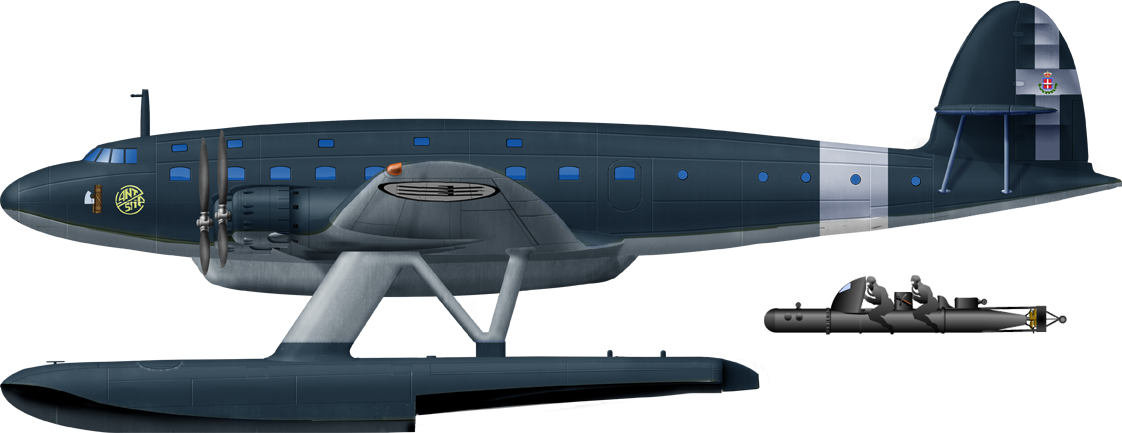
Prototype N°I Livery in Grigio Azzuro Scuro Marino and Grigio Azzuro Schiario below, and a SCL Maiale intended to be deployed, perhaps on an offensive on New York Harbour (in reality this was to be a leaflet drop from BETASOM in Bordeaux).
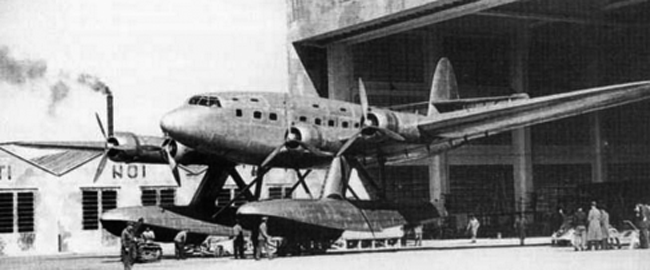
M.386 freshly completed at Montfalcone
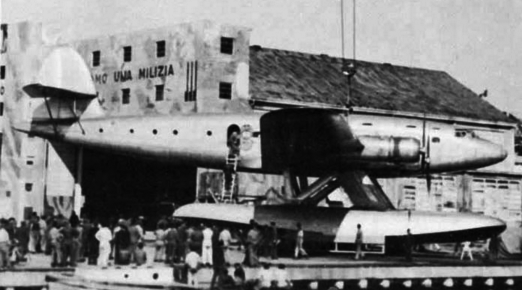
M.383 being lifted up to the sea
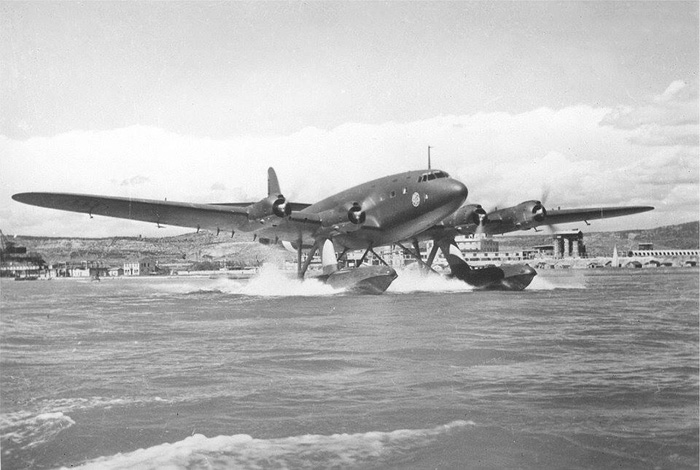
Take-off army/navy trials of the Z.511 first prototype under her final livery in August 1942
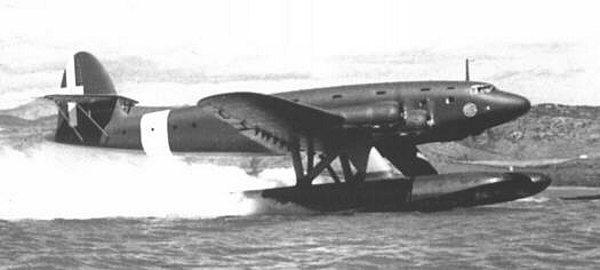
Same from another angle.
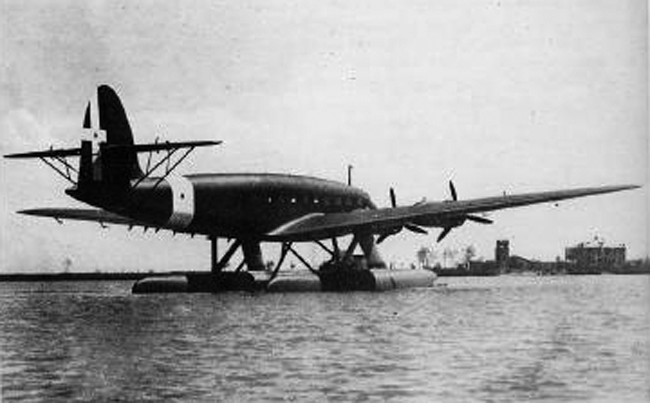
Rear View, August 1942
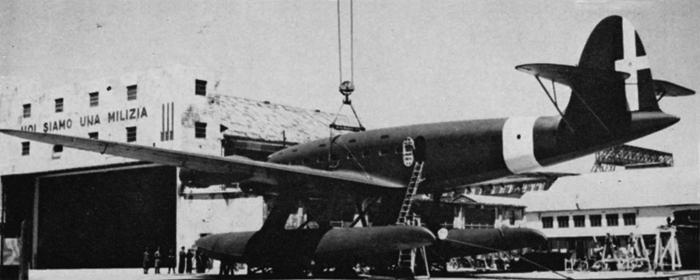
Being lifted up back to the berth, 1942
Read More/Src
Dimensione Cielo Volume 9 Trasporto Edizioni Bizzarri, Rome 1976Links
airpages.ruangelfire.com
facebook.com
stormomagazine.com
uasvision.com
alchetron.com
alieuomini.it/
ww2eagles.blogspot.com
rarebirdmodels.com
alchetron.com
cyberaerobreton.fr
en.wikipedia.org
Model Kits
On scalemates: RareBirdModels 1:72 and 1:144Video
Another Video on the raid on New York
- Lohner E (1913)
- Macchi M3 (1916)
- Macchi M5 (1918)
- Ansaldo ISVA (1918)
- Sopwith Baby (1916)
- Short 184 (1916)
- Fairey Campania (1917)
- Sopwith Cuckoo (1917)
- Felixstowe F.2 (1917)
- Friedrichshafen FF 33 (1916)
- Albatros W4 (1916)
- Albatros W8 (1918)
- Hanriot HD.2
- Grigorovitch M5
- IJN Farman MF.7
- IJN Yokosho Type Mo
- Yokosho Rogou Kougata (1917)
- Yokosuka Igo-Ko (1920)
- Curtiss N9 (1916)
- Aeromarine 39
- Vought VE-7
- Douglas DT (1921)
- Boeing FB.5 (1923)
- Boeing F4B (1928)
- Vought O2U/O3U Corsair (1928)
- Supermarine Seagull (1922)
- Blackburn Ripon (1926)
- Fairey IIIF (1927)
- Fairey Seal (1930)
- LGL-32 C.1 (1927)
- Caspar U1 (1921)
- Dornier Do J Wal (1922)
- Rohrbach R-III (1924)
- Mitsubishi 1MF (1923)
- Mitsubishi B1M (1923)
- Yokosuka E1Y (1923)
- Nakajima A1N (1927)
- Nakajima E2N (1927)
- Mitsubishi B2M (1927)
- Nakajima A4N (1929)
- CANT 18
WW1
✠ K.u.K. Seefliegerkorps:
 Italian Naval Aviation
Italian Naval Aviation
 RNAS
RNAS
 Marineflieger
Marineflieger
 French Naval Aviation
French Naval Aviation
 Russian Naval Aviation
Russian Naval Aviation
 IJN Air Service
IJN Air Service
 USA
USA
Interwar
 Interwar US
Interwar US
 Interwar Britain
Interwar Britain
 Interwar France
Interwar France
 Interwar Germany
Interwar Germany
 Interwar Japan
Interwar Japan
 Interwar Italy
Interwar Italy
- Curtiss SOC seagull (1934)
- Grumman FF (1931)
- Curtiss F11C Goshawk (1932)
- Grumman F2F (1933)
- Grumman F3F (1935)
- Northrop BT-1 (1935)
- Grumman J2F Duck (1936)
- Consolidated PBY Catalina (1935)
- Brewster/NAF SBN-1 (1936)
- Curtiss SBC Helldiver (1936)
- Vought SB2U Vindicator (1936)
- Brewster F2A Buffalo (1937)
- Douglas TBD Devastator (1937)
- Vought Kingfisher (1938)
- Curtiss SO3C Seamew (1939)
- Douglas SBD Dauntless (1939)
- Grumman F4F Wildcat (1940)
- F4U Corsair (NE) (1940)
- Brewster SB2A Buccaneer (1941)
- Grumman TBF/TBM Avenger (1941)
- Consolidated TBY Sea Wolf (1941)
- Grumman F6F Hellcat (1942)
- Curtiss SB2C Helldiver (1942)
- Curtiss SC Seahawk (1944)
- Grumman F8F Bearcat (1944)
- Ryan FR-1 Fireball (1944)
- Douglas AD-1 Skyraider (1945)
Fleet Air Arm
- Fairey Swordfish (1934)
- Blackburn Shark (1934)
- Supermarine Walrus (1936)
- Fairey Seafox (1936)
- Blackburn Skua (1937)
- Short Sunderland (1937)
- Blackburn Roc (1938)
- Fairey Albacore (1940)
- Fairey Fulmar (1940)
- Grumman Martlet (1941)
- Hawker sea Hurricane (1941)
- Brewster Bermuda (1942)
- Fairey Barracuda (1943)
- Fairey Firefly (1943)
- Grumman Tarpon (1943)
- Grumman Gannet (1943)
- Supermarine seafire (1943)
- Blackburn Firebrand (1944)
- Hawker Sea Fury (1944)
IJN aviation
- Aichi D1A "Susie" (1934)
- Mitsubishi A5M "Claude" (1935)
- Nakajima A4N (1935)
- Yokosuka B4Y "Jean" (1935)
- Mitsubishi G3M "Nell" (1935)
- Nakajima E8N "Dave" (1935)
- Kawanishi E7K "Alf" (1935)
- Nakajima B5N "Kate" (1937)
- Kawanishi H6K "Mavis" (1938)
- Aichi D3A "Val" (1940)
- Mitsubishi A6M "zeke" (1940)
- Nakajima E14Y "Glen" (1941)
- Nakajima B6N "Jill" (1941)
- Mitsubishi F1M "pete" (1941)
- Aichi E13A Reisu "Jake" (1941)
- Kawanishi E15K Shiun "Norm" (1941)
- Nakajima C6N Saiun "Myrt" (1942)
- Yokosuka D4Y "Judy" (1942)
- Kyushu Q1W Tokai "Lorna" (1944)
Luftwaffe
- Arado 196 (1937)
- Me109 T (1938)
- Blohm & Voss 138 Seedrache (1940)
Italian Aviation
- Savoia-Marchetti S.55
- IMAM Ro.43/44
- CANT Z.501 Gabbiano
- CANT Z.506 Airone
- CANT Z.508
- CANT Z.511
French Aeronavale
- GL.300 (1926-39)
- Levasseur PL.5 (1927)
- Potez 452 (1935)
- Loire 210 (1936)
- Loire 130 (1937)
- LN 401 (1938)
Soviet Naval Aviation
- Shavrov SH-2 (1928)
- Tupolev TB-1P (1931)
- Beriev MBR-2 (1930)
- Tupolev MR-6 (1933)
- Tupolev MTB-1 (1934)
- Beriev Be-2 (1936)
- Polikarpov I16 naval (1936)
- Tupolev MTB-2 (1937)
- Ilyushine DB-3T/TP (1937)
- Beriev Be-4 (1940)
-
Skoda Š-328V
R-XIII Idro
Fokker C.XI W (1934)
WW2
- De Havilland Sea Vixen
- Hawker Sea Hawk
- Supermarine Scimitar
- Blackburn Buccaneer
- Hawker Sea Harrier
- Douglas A4 Skyhawk
- Grumman F9F Panther
- Vought F8 Crusader
- McDonnell-Douglas F-4 Phantom-II
- North Am. A5 Vigilante
- TU-142
- Yak 38 forger
☢ Cold War
✧ NATO
 Fleet Air Arm
Fleet Air Arm
 US Navy
US Navy
☭ Warsaw Pact
Merch
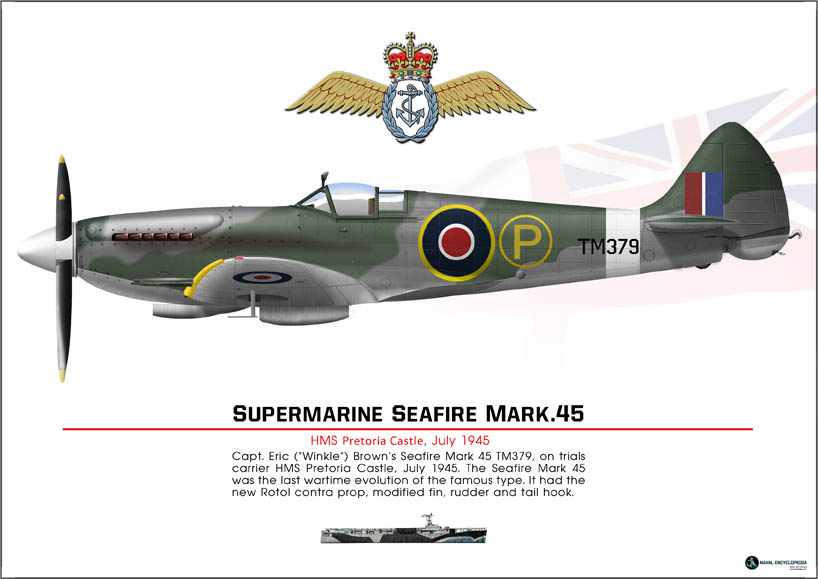
Seafire Mark 45; HMS Pretoria Castle
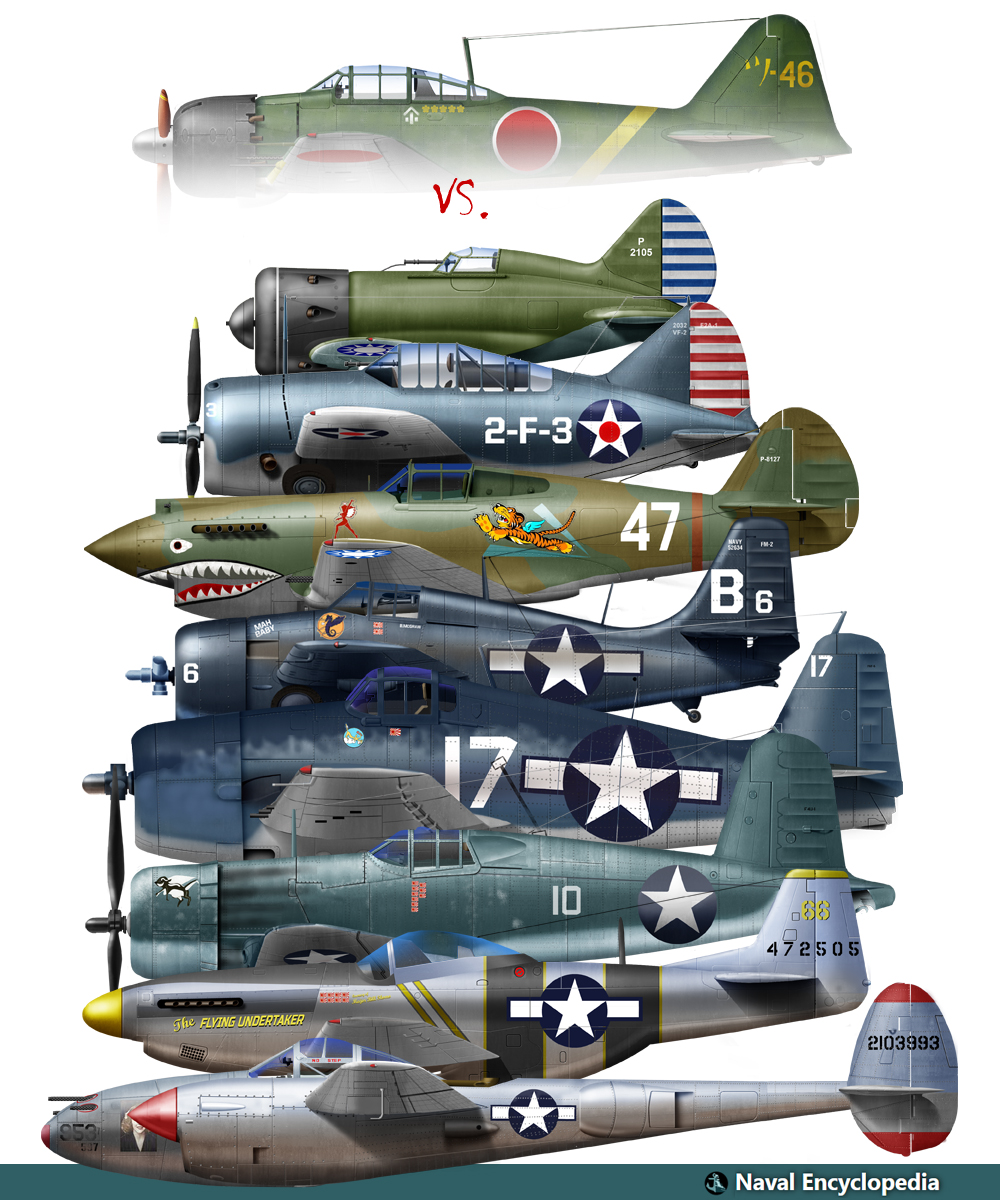
Zeros vs its aversaries
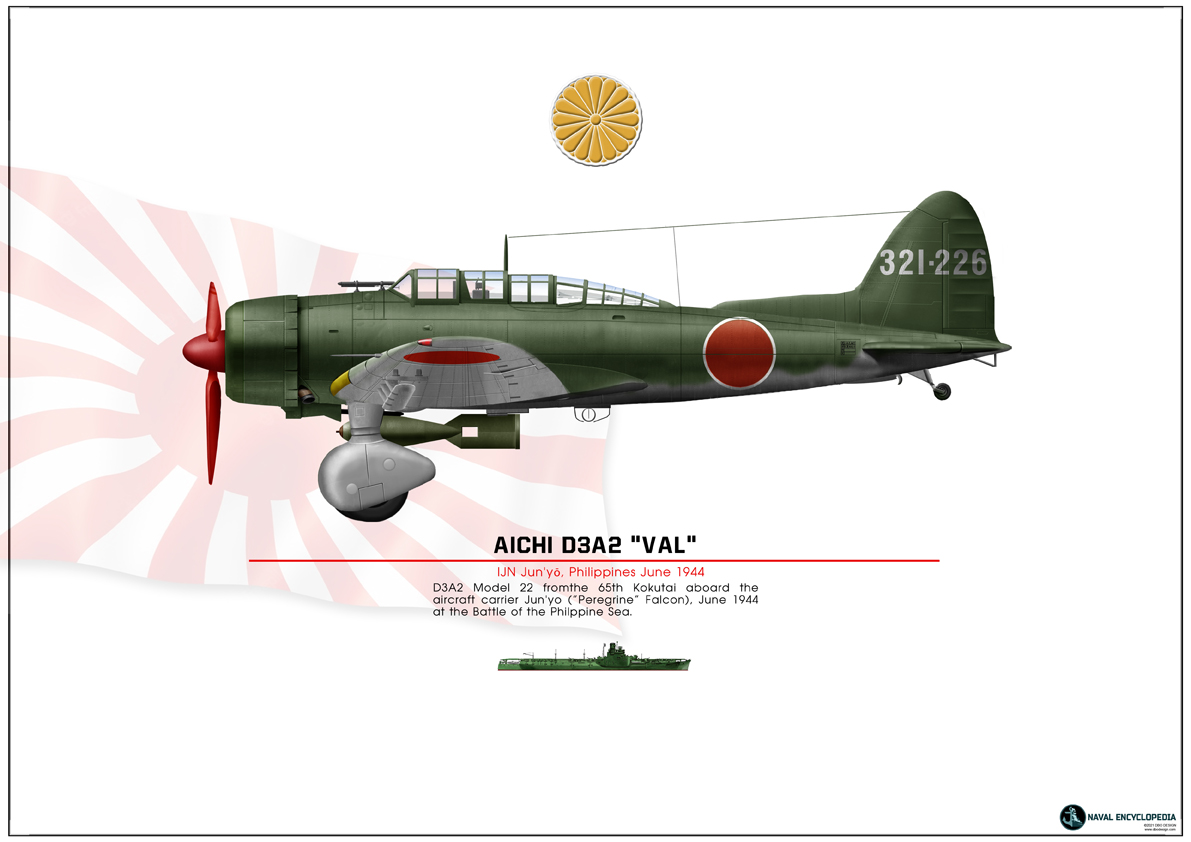
Aichi D3A “Val” Junyo
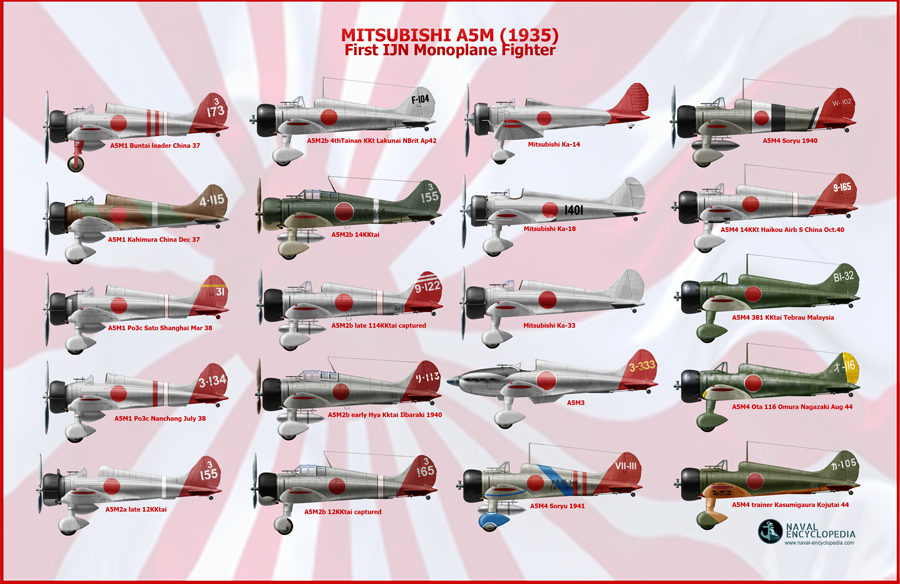
Mitsubishi A5M poster
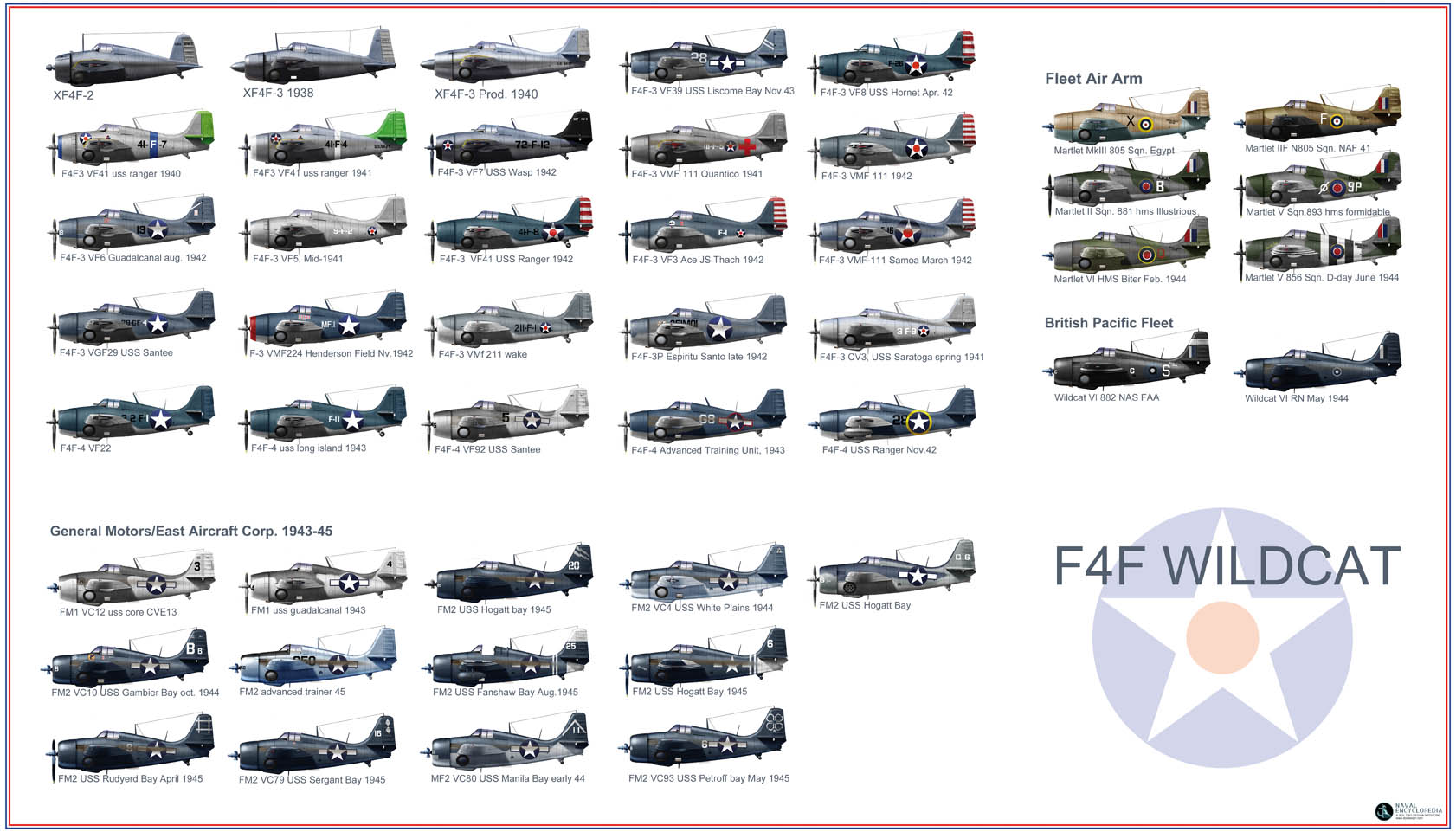
F4F wildcat
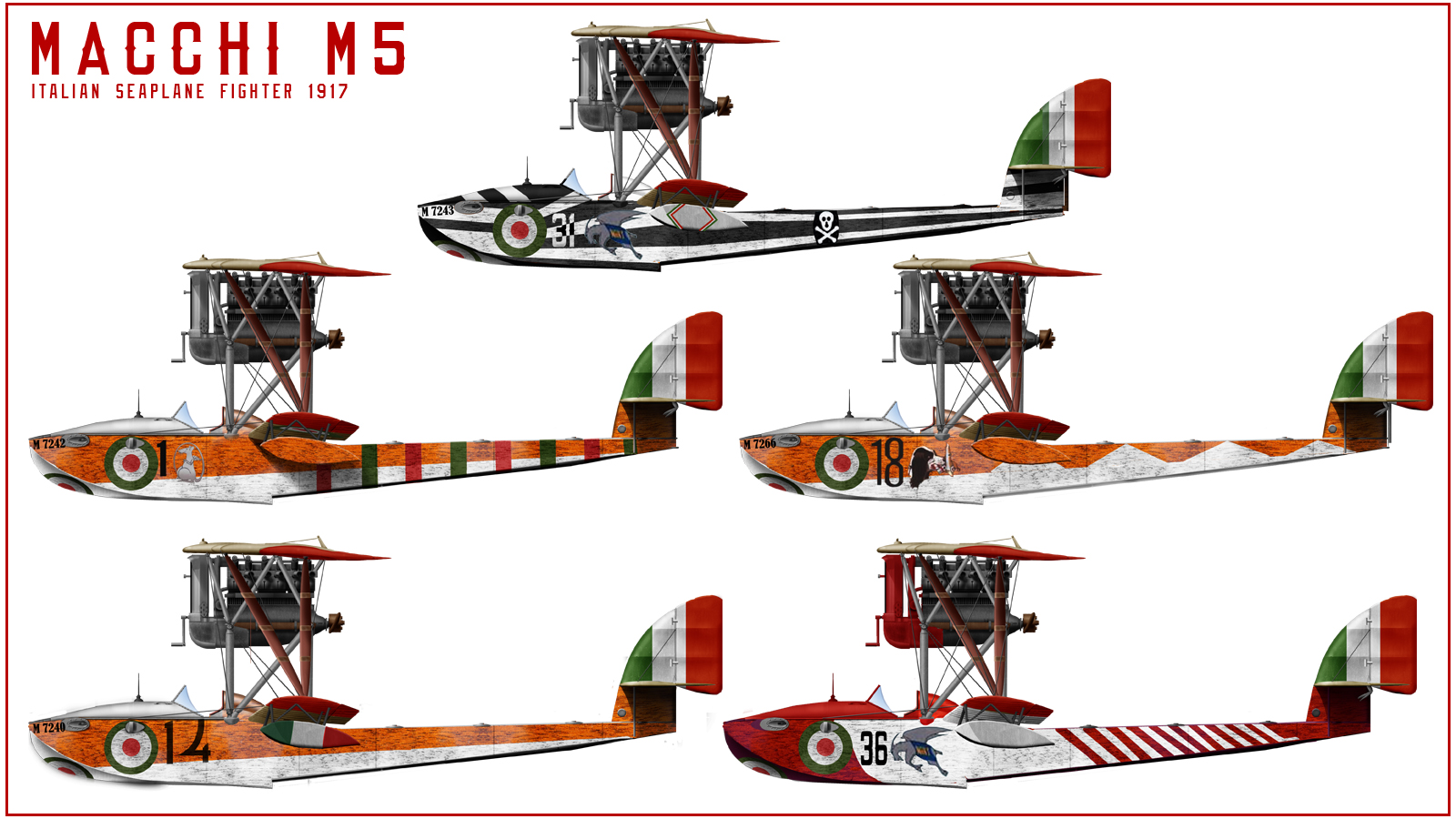
Macchi M5
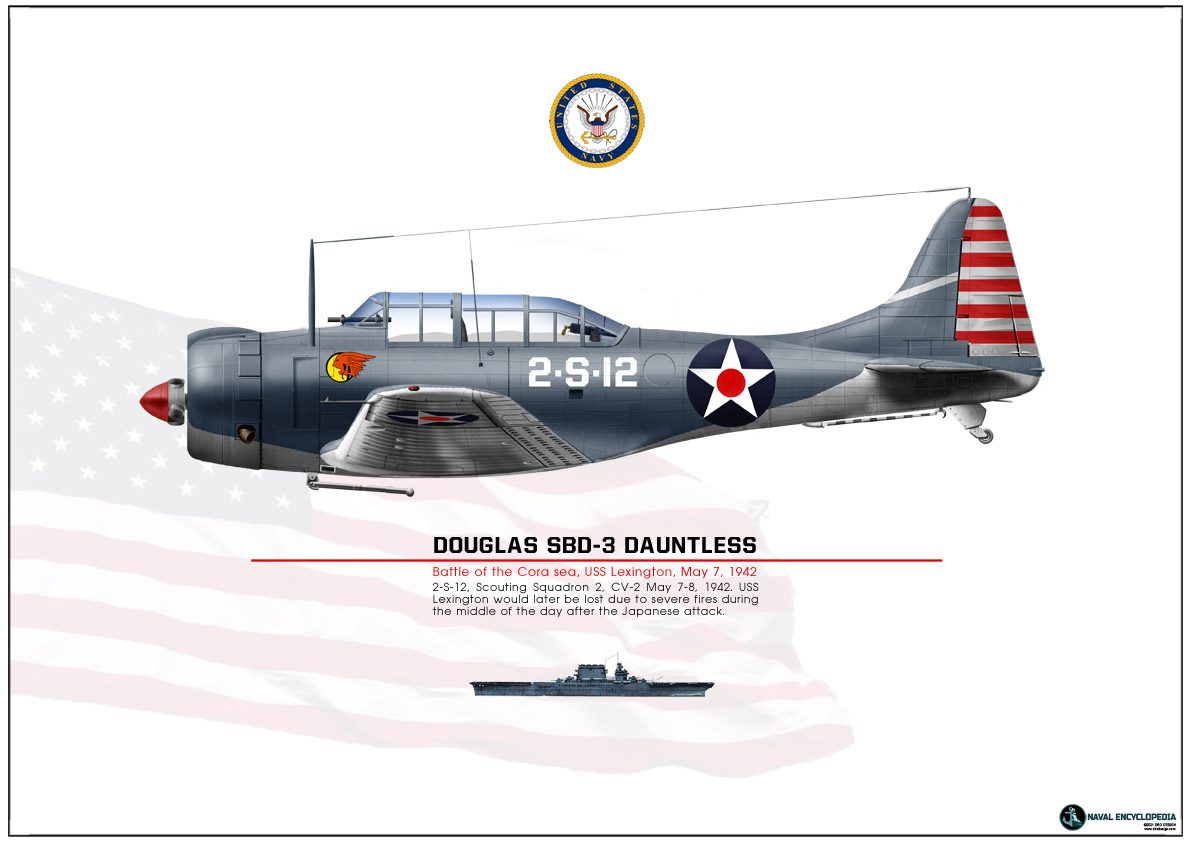
SBD Dauntless Coral Sea
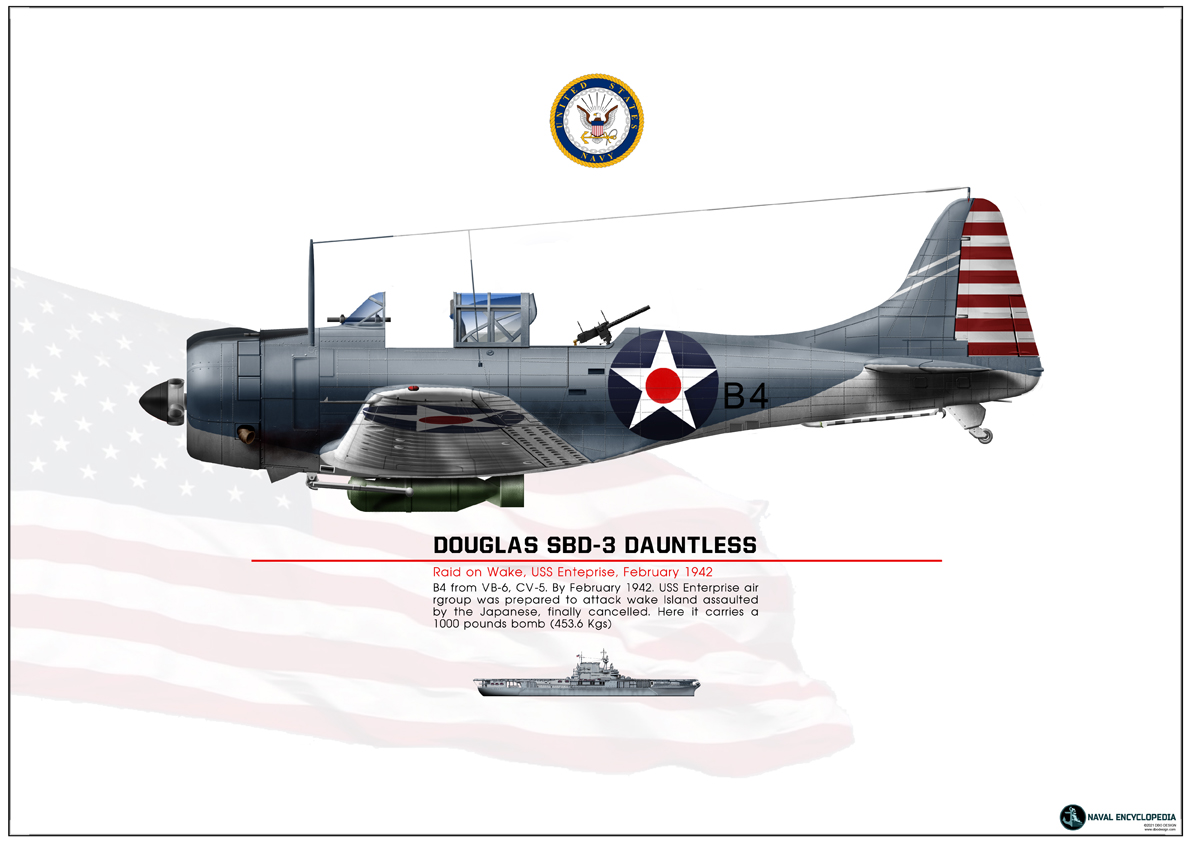
SBD Dauntless USS Enterprise
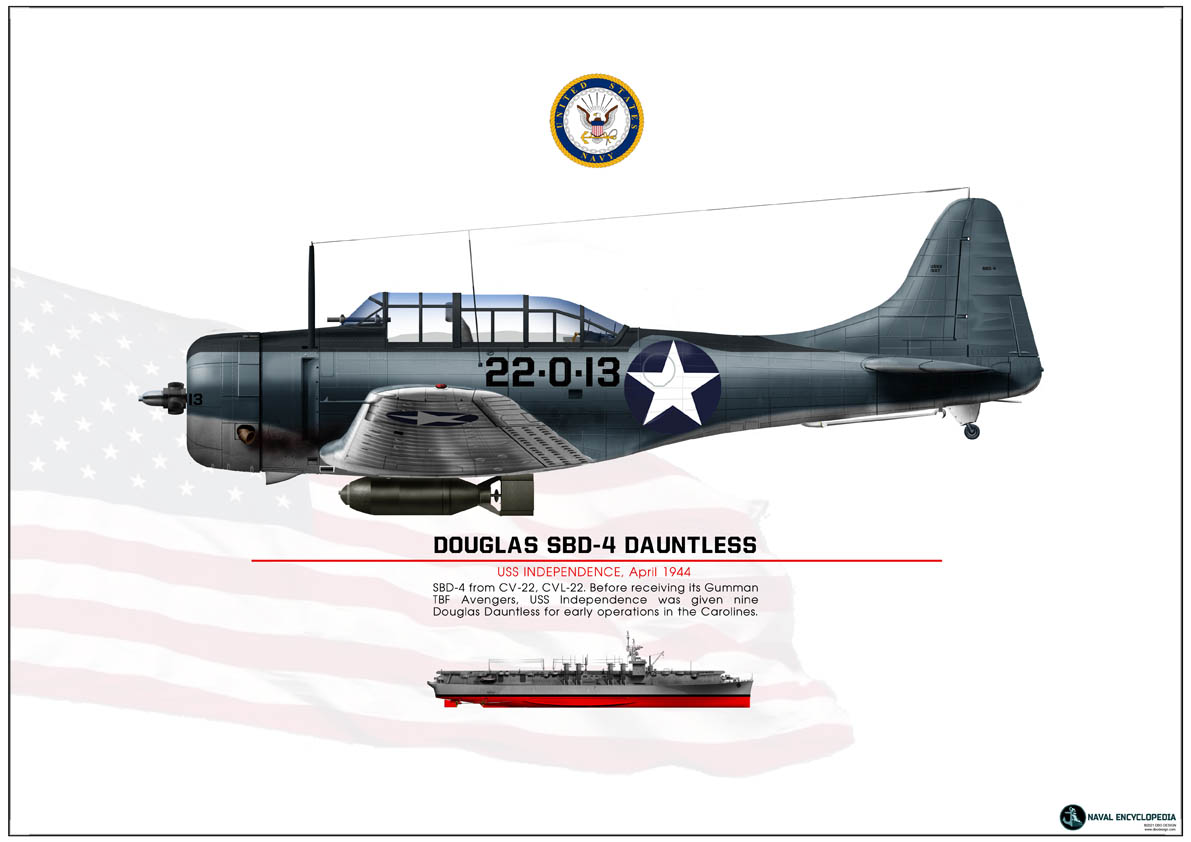
SBD-4 CV22